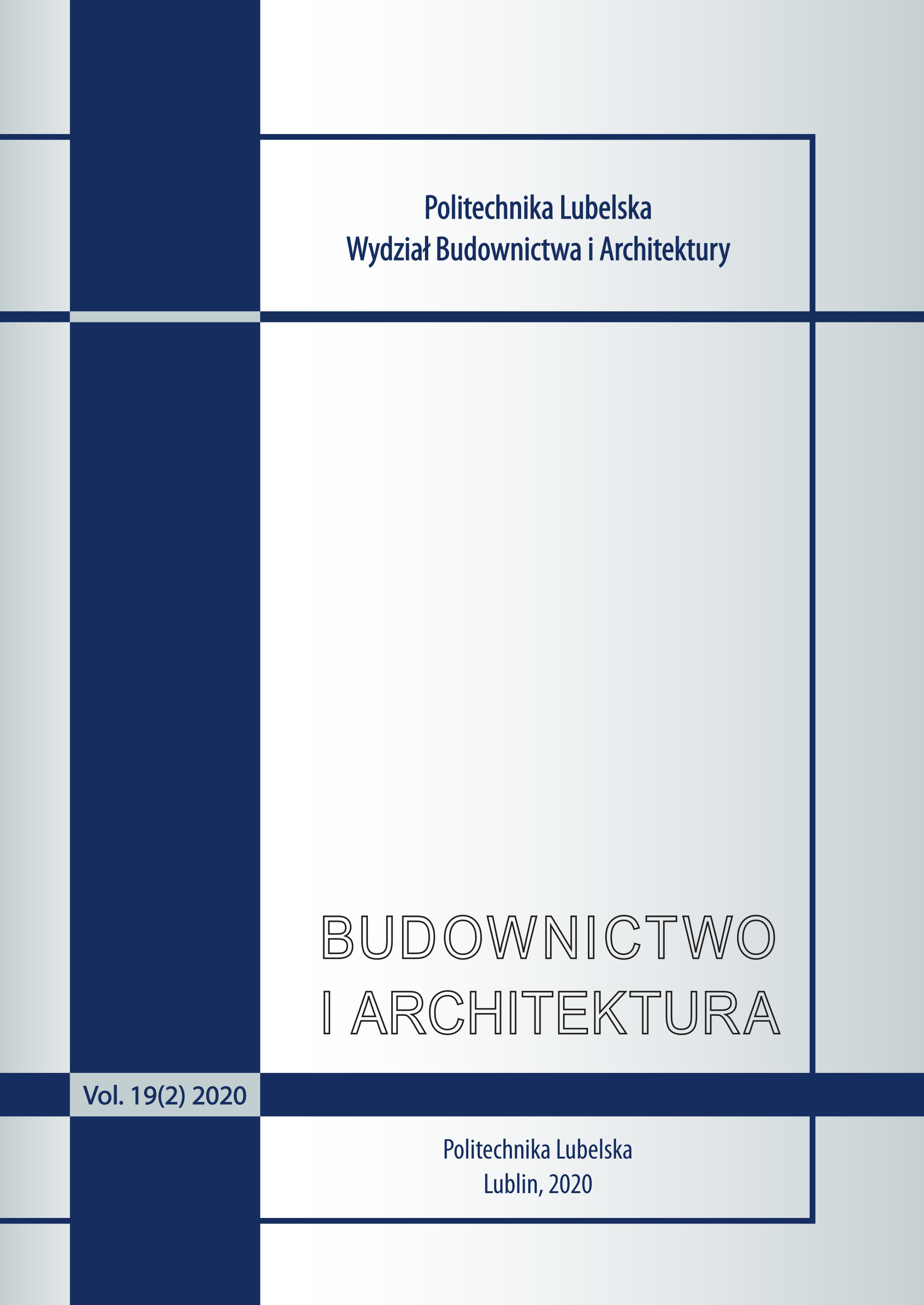Use of applications and rendering engines in architectural design – state-of-the-art
Article Sidebar
Open full text
Issue Vol. 22 No. 1 (2023)
-
Use of applications and rendering engines in architectural design – state-of-the-art
Andrzej Borkowski, Piotr Nowakowski005-014
-
Optimization of the functional concept of the minimum apartment – a study on a selected example. The role of functional details
Andrzej Tokajuk015-024
-
Efficiency comparison of mixture formulations in the stabilisation/solidification of the loess silt contaminated with zinc in terms of mechanical properties
Agnieszka Lal, Joanna Fronczyk, Małgorzata Franus025-035
Archives
-
Vol. 24 No. 4
2025-12-16 13
-
Vol. 24 No. 3
2025-09-30 13
-
Vol. 24 No. 2
2025-06-25 13
-
Vol. 24 No. 1
2025-03-31 12
-
Vol. 23 No. 4
2025-01-02 11
-
Vol. 23 No. 3
2024-10-07 10
-
Vol. 23 No. 2
2024-06-15 8
-
Vol. 23 No. 1
2024-03-29 6
-
Vol. 22 No. 4
2023-12-29 9
-
Vol. 22 No. 3
2023-09-29 5
-
Vol. 22 No. 2
2023-06-30 3
-
Vol. 22 No. 1
2023-03-30 3
-
Vol. 21 No. 4
2022-12-14 8
-
Vol. 21 No. 3
2022-11-02 3
-
Vol. 21 No. 2
2022-08-31 3
-
Vol. 21 No. 1
2022-03-30 3
-
Vol. 20 No. 4
2021-12-29 6
-
Vol. 20 No. 3
2021-10-29 8
-
Vol. 20 No. 2
2021-06-02 8
-
Vol. 20 No. 1
2021-02-09 8
Main Article Content
DOI
Authors
piotr.nowakowski5.stud@pw.edu.pl
Abstract
Computer methods in the AEC (Architecture, Engineering, Construction) industry are constantly evolving, mainly towards BIM, and the design process itself within an investment project focuses mainly on documentation. Visualisation or animation are optional elements, mostly done for sales purposes. Photorealism and the quality of created visualisations influence the impressions of the recipient, and the emotions evoked can determine a purchase or investment. As a rule, designers pay great attention to the visualisations they create, but they are not always aware of the solutions available on the market in this respect. In recent decades, rendering engines based on so-called real-time rendering have developed rapidly. The aim of the study was to provide a deep review of existing 3D modelling and visualisation solutions in terms of their popularity, applicability and advantages and limitations. The focus is on applications working with BIM software, which is widely used in the AEC industry. The paper attempts to compare the applications, lists their advantages, disadvantages, benefits and limitations in their use. The conclusions, sometimes subjective, can be useful for the whole community of architects and engineers, related to space design. The results of the review indicate the increasing popularity of 'real-time' solutions, which are displacing 'offline' solutions.
Keywords:
References
Shannon T., Unreal Engine 4 for Design Visualization: Developing Stunning Interactive Visualizations, Animations, and Renderings. Pearson Education, 2017.
Riener R. and Harder M., Virtual Reality in Medicine. London: Springer, 2012. https://doi.org/10.1007/978-1-4471-4011-5 DOI: https://doi.org/10.1007/978-1-4471-4011-5_1
Wu H., Virtual reality - improving the fidelity of architectural visualization. MSc Thesis, Texas Tech University, Lubbock, 2006. Available: https://ttu-ir.tdl.org/bitstream/handle/2346/12601/hao_wu_thesis.pdf [Accessed: 26 Jun 2022]
Chen L., Architectural Visualization An Analysis from Human Visual Cognition Process. Melbourne: Monash University, 2004. Available: http://citeseerx.ist.psu.edu/viewdoc/download?doi=10.1.1.135.3081&rep=rep1&type=pdf [Accessed: 26 Jun 2022]
Czmoch I. and Pękala A., “Traditional Design versus BIM Based Design”, in Procedia Engineering 91, 2014, pp. 210 – 215. https://doi.org/10.1016/j.proeng.2014.12.048 DOI: https://doi.org/10.1016/j.proeng.2014.12.048
Dzudzińska E., “Proposal of a workflow for data-driven design in combination with BIM technology for more efficient office space planning”, Budownictwo i Architektura, vol 21, no. 2, 2022, pp. 5-16. https://doi.org/10.35784/bud-arch.2905 DOI: https://doi.org/10.35784/bud-arch.2905
Gleń, P. and Krupa, K., “Comparative analysis of the inventory process using manual measurements and laser scanning”, Budownictwo i Architektura, vol. 8, no. 2, 2019, pp. 21-30. https://doi.org/10.35784/bud-arch.552 DOI: https://doi.org/10.35784/bud-arch.552
Wang J., Wang X., Shou W. and Xu B., “Integrating BIM and augmented reality for interactive architectural visualisation”, Construction Innovation, vol. 14, no. 4, 2014, pp. 453-476. https://doi.org/10.1108/CI-03-2014-0019 DOI: https://doi.org/10.1108/CI-03-2014-0019
Okun J.A. and Zwerman S., The VES Handbook of Visual Effects. 3rd ed., New York: Routledge, 2020. https://doi.org/10.4324/9781351009409 DOI: https://doi.org/10.4324/9781351009409
Chaos Group, Architectural Visualization Technology Report. 2017, Available: https://www.pccpolska.pl/wp-content/uploads/2018/01/Wizualizacje-architektoniczne-raport-od-Chaos-Group.pdf [Accessed: 26 Jun 2022]
NBS, 10th Annual BIM Report. Available: https://www.thenbs.com/knowledge/national-bim-report-2020 [Accesed: 26 Jun 2022]
Ma Y-P., “Extending 3D-GIS District Models and BIM-Based Building Models into Computer Gaming Environment for Better Workflow of Cultural Heritage Conservation”, Applied Sciences, vol. 11, no. 5: 2101, 2021. https://doi.org/10.3390/app11052101 DOI: https://doi.org/10.3390/app11052101
Yan W., Culp C. and Graf R., “Integrating BIM and gaming for real-time interactive architectural visualization”, Automation in Construction, vol. 20, no. 4. 2011. https://doi.org/10.1016/j.autcon.2010.11.013 DOI: https://doi.org/10.1016/j.autcon.2010.11.013
Żakowska, L., "Wizualizacja, modelowanie i analizowanie przestrzeni transportu miejskiego w aspekcie estetycznym", Budownictwo i Architektura, vol. 13, no.1, 2014, pp. 203-211. https://doi.org/10.35784/bud-arch.1940 DOI: https://doi.org/10.35784/bud-arch.1940
Zima, K., "Integracja dokumentacji w procesie budowlanym z wykorzystaniem modelowania informacji o budynku", Budownictwo i Architektura, vol. 12, no.1, 2013, pp. 77-84. https://doi.org/10.35784/bud-arch.2176 DOI: https://doi.org/10.35784/bud-arch.2176
Heins E. and Akenine-Möller T., Ray Tracing Gems. High-Quality and Real-Time Rendering with DXR and Other APIs. Berkeley: Springer Nature, 2019, pp. 607. https://doi.org/10.1007/978-1-4842-4427-2 DOI: https://doi.org/10.1007/978-1-4842-4427-2
Alsadoon E., Alkhawajah A. and Suhaim A.B., “Effects of a gamified learning environment on students’ achievement, motivations, and satisfaction”, Heliyon, vol. 8, no. 8, 2022, e10249, https://doi.org/10.1016/j.heliyon.2022.e1024 DOI: https://doi.org/10.1016/j.heliyon.2022.e10249
Abdulrahaman M.D. et al., “Multimedia tools in the teaching and learning processes: A systematic review”, Heliyon, vol. 6, no. 11, 2020, e05312, https://doi.org/10.1016/j.heliyon.2020.e05312 DOI: https://doi.org/10.1016/j.heliyon.2020.e05312
Article Details
Abstract views: 388
License

This work is licensed under a Creative Commons Attribution-ShareAlike 4.0 International License.
Budownictwo i Architektura supports the open science program. The journal enables Open Access to their publications. Everyone can view, download and forward articles, provided that the terms of the license are respected.
Publishing of articles is possible after submitting a signed statement on the transfer of a license to the Journal.






